I’m still mentally processing our roadtrip/plane-trip in Canada last month. And generating a few more posts. Today’s post is about the totem poles we saw in Canada.
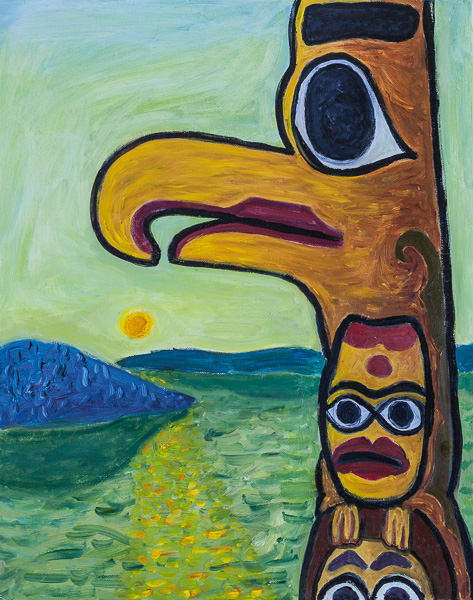
“Beak Totem,” oil on canvas, August, 2014, 16” x 20”. Click for a larger version of the painting.
Dig the beak on this totem god. I’m not sure what kind of bird he is. Eagle? I just finished painting him today. The background is drawn from a sunset view over Lac Desert, the place that I talked about in the previous post. If you want to buy “Beak Totem,” check out the price-list on my Paintings page.
While in Ottawa, we went to the Canadian Museum of History, all kinds of stuff in there. The place was formerly called the Museum of Civilization. We focused on the First Nations art, like masks and totem poles, some of them antique, some of them newer pieces made by Native Americans, mostly on the west coast of Canada.
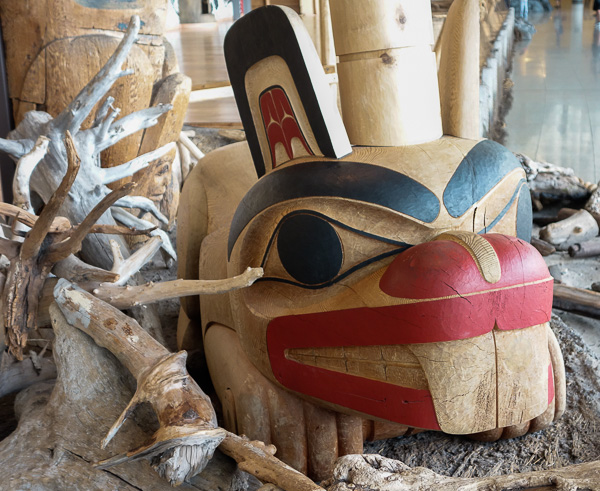
I really liked this sculpture of a sinister beaver god, made by the Haida artist Jim Hart in 1993. The object is meant to be a stand on which to place a chief’s coffin.
A side note, we saw the first-ever Canadian stamp, and it has a beaver on it. The Algonquin man, Don, who was our fishing guide told up in Lac Desert, told us a funny beaver story. At certain times of the year, beavers travel, going across the land looking for a new pond or creek to make their own. Don saw a beaver in his backyard, looking over his spring for possible colonization. Don chased the beaver off by brandishing his Whipper Snipper weed cutter. The beaver slapped his tail (their method, in the water, of alerting fellow beavers to danger) and then banged his nose on the ground—in a frustrated attempt to dive. And then the beaver moved on.
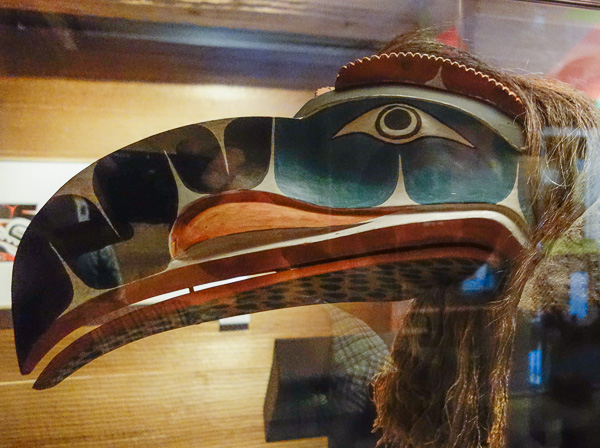
I’m very big on crow masks. Those giant beaks! I love fairy tales about crows and ravens as well. If I was ever reincarnated my three top choices are: crow, brown pelican, and a Big Sur cow.
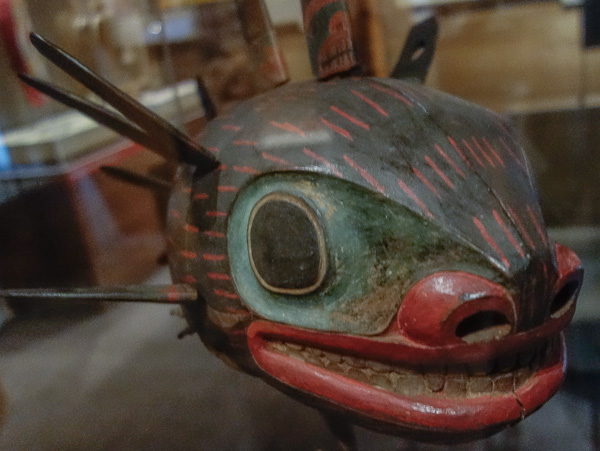
Carving of a fish.
The Canadian Museum of History has a really large hall on one side, with ceiling that’s several stories high. About thirty totem poles are on display here, most of them dating from the late 1800s, which was the heyday of totem-building in the Pacific Northwest. The heyday only lasted a for a few decades.
Before the traders arrived, the west coast Native Americans were carving stone or wooden figurines with primitive knives. But then – then the sailing ships came, and the strangers brought steel axes. And—wow! Huge totem poles, from Oregon to Alaska!
But the traders brought syphilis and smallpox. And the missionaries banned the natives’ religion. The world they knew by heart become someone else’s “New World.” And the white man carried the totem poles off to museums.
I’ve always wanted to write an SF story based on this scenario, and these days I’m working on such a story with Bruce Sterling—the quote above is taken from a draft. In the story, some aliens bring humanity some incredibly powerful tools, and we create amazing stuff, and then it ends with unexpected outcomes.
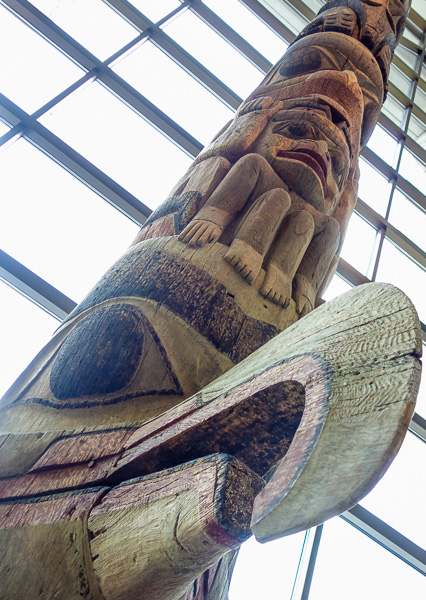
A view of that pole I painted. One of the totem poles in the museum had a note saying that they’d helpfully repaired the pole, moved it to the museum, and given the Native American village a reproduction of the pole—cast from plastic, I think.
I saw a giant salmon on one totem pole. You see beavers, frogs, wolves, crows, eagles and bears as well. Plus the legendary bird they call a thunderbird—the thunderbird is a little like Jove or Thor, he beats up storms with his wings and sends out lightning bolts.
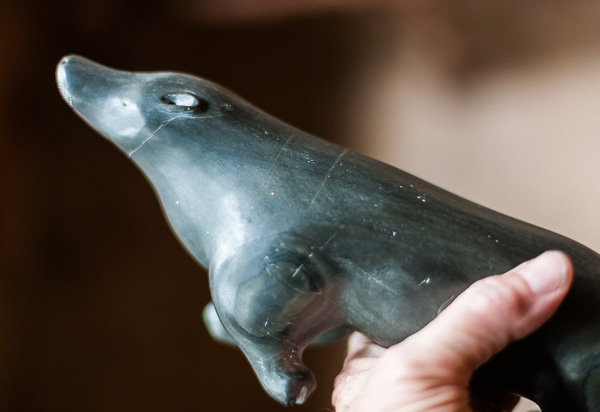
As a side note, my brother’s wife Joanie has a few nice pieces of Inuit art in her cabin. Like this seal. I remember carving a wooden seal in shop in the eighth grade. I didn’t make mine curvy enough. I liked holding this stone Inuit seal. A power object. A little sculpture like this is in some sense like a phrase or an image or a paradoxical bit of logic—a tradition-polished thought that you can caress and ponder.
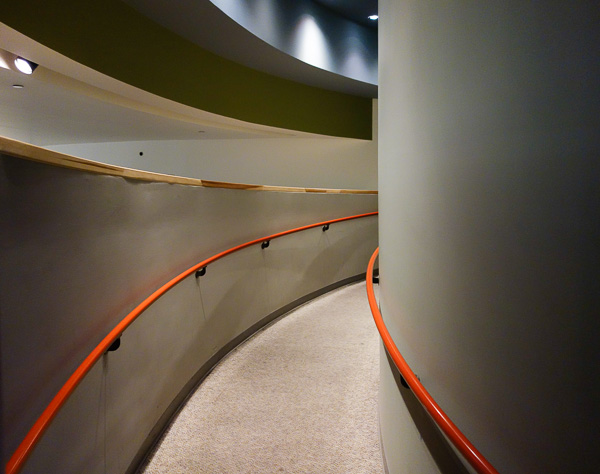
A nice curved ramp in some dusty recess of the Canadian Historical Museum.
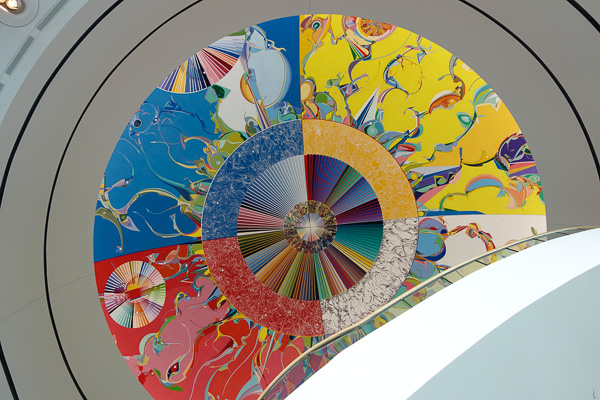
And a great mural, Morning Star, on the ceiling of the big totem-pole hall, by native artist Alex Janvier. Here’s a video clip of the unveiling in 1993.
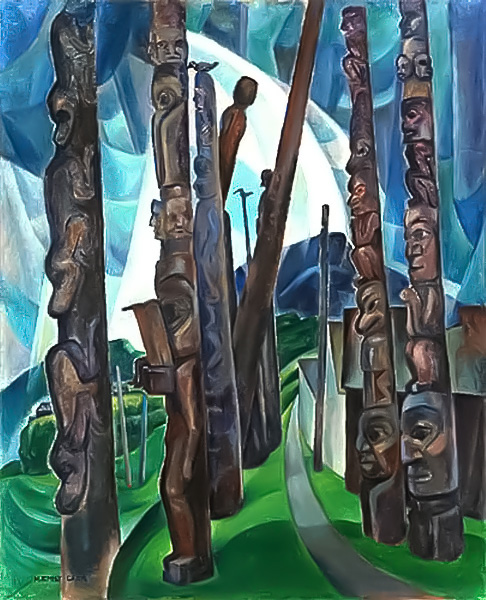
Kitwancool by Emily Carr. 1928. Oil on Canvas. About 32″ x 40″. At Vancouver Art Gallery.
In the first half of the twentieth century, the artist Emily Carr, working around Victoria in British Columbia, did some really wonderful paintings that included totem poles and First Nations art. On our way back home, we saw several of Emily Carr’s paintings in Vancouver Art Gallery, and in the past (on an earlier trip to the Northwest) we saw a bunch of them at the art museum on the island of Victoria.
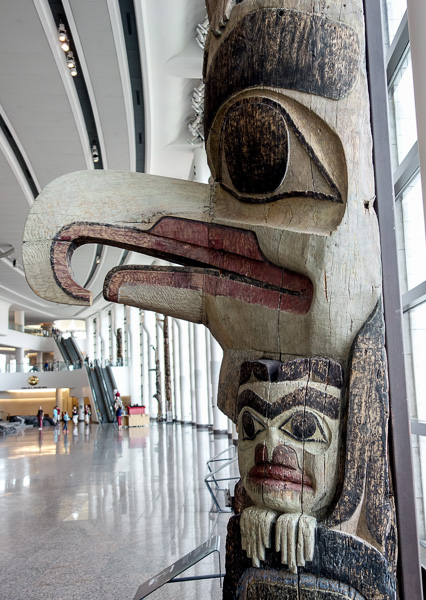
Here’s the photo that I used as a model for my totem pole painting—I didn’t want to post this image right next to my painting, as the full-blown funky original blows me out of the water. This said, I’m happy with the way mine came out. I think I’ll do a bigger totem pole painting next week, drawing extra inspiration from Emily Carr on this next one.









August 21st, 2014 at 10:11 am
Just got home from a brief trip to the Olympic Peninsula and read this post about Vancouver. My wife and I stayed at the Sylvia Hotel about 18 months ago, it’s a great location what with the beach trail and Stanley Park, and all the great restaurants within easy walking distance. The VAG is a wonderful museum, so glad you had a good time there.